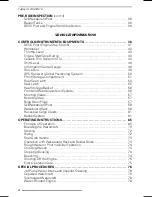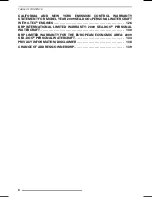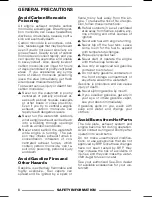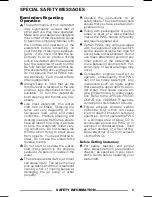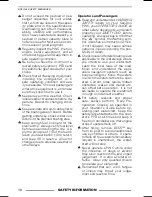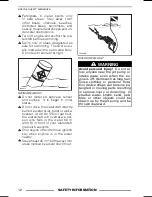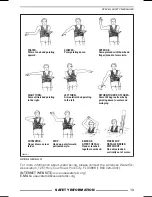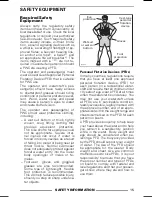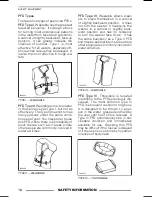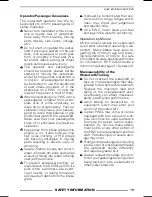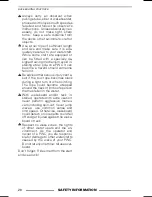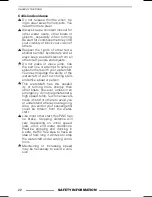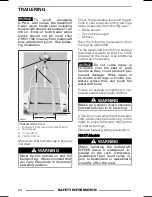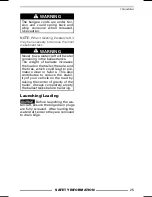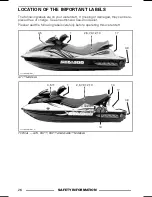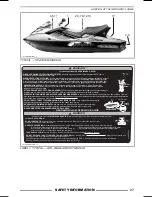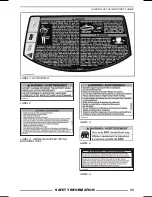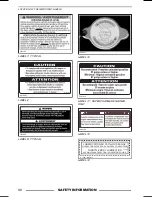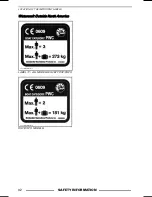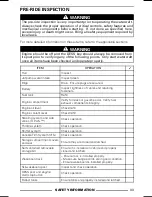
SAFE BOATING PRACTICES
YOU are responsible for your own
safety, the safety of your passengers,
and the safety of fellow boaters. Ride
smart from the start and we all win!
Drugs and Alcohol
Do not use drugs or drink alcohol while
operating a PWC. Like driving a car,
driving a watercraft requires sober, at-
tentive care. Operating a watercraft
while intoxicated or under the influ-
ence of drugs is not only dangerous,
but it is also a Federal offense carry-
ing a significant penalty. These laws
are vigorously enforced. The use of
drugs and alcohol, singly or in combi-
nation, decreases reaction time, im-
pedes judgment, impairs vision, and
inhibits your ability to safely operate a
watercraft.
WARNING
Alcohol consumption and boat-
ing do not mix! Operating un-
der the influence endangers the
lives of your passengers and other
boaters. Federal laws prohibit op-
erating a watercraft under the in-
fluence of alcohol or drugs.
Safe Operation
Always keep in mind that as the
throttle lever is released to idle posi-
tion, less directional control is avail-
able, and as the engine is off, di-
rectional control is lost. You need
throttle to steer.
Know the waters in which the wa-
tercraft is to be operated. Current,
tides,
rapids,
hidden obstacles,
wakes and waves etc. can affect
safe operation. It is not advisable to
operate the watercraft in rough or
inclement weather.
Keep the safety lanyard attached to
the operator’s PFD at all times and
keep it free from handlebars so that
engine stops if operator falls off. Af-
ter riding, remove DESS™ key from
its post to avoid unauthorized use by
children or others. If operator falls
off the watercraft and safety lanyard
is unattached, the watercraft will
not stop.
Ride within your limits and level of
riding ability. Avoid aggressive ma-
neuvers to reduce the risk of loss
of control, ejection and collision.
Understand and respect the perfor-
mance or your watercraft.
Always ride responsibly and safely.
Use common sense and courtesy.
While your watercraft has the ca-
pacity of operating at high speeds,
it is strongly recommended that
high speed operation only be ap-
plied when ideal conditions exist
and are permitted. Higher speed
operation requires a higher degree
of skill and increases the risk of se-
vere injuries.
The forces generated on the body
of riders while turning, negotiat-
ing waves or wakes, operating in
choppy waters, or falling off the wa-
tercraft, especially at higher speeds,
may cause injury including the pos-
sibility of broken legs and other
bones or more serious injuries. Re-
main flexible and avoid sharp turns.
In shallow water, proceed with
caution and at very low speeds.
Grounding or abrupt stops may re-
sult in injury. Debris may also be
picked up and be thrown rearward
by the jet pump onto people or prop-
erty.
Do not use the watercraft’s reverse,
if so equipped, to stop. You or your
passenger(s)
could
be
violently
ejected forward onto the handle-
bars or even off the watercraft onto
the hazard.
PWCs are not designed for night-
time operation.
18
_______
SAFETY INFORMATION
________
Содержание 2009 Sea-Doo GTI Series
Страница 9: ...SAFETY INFORMATION ________ SAFETY INFORMATION ________ 7...
Страница 30: ...LOCATION OF THE IMPORTANT LABELS F16L0PL LABEL 1 TYPICAL RXP MODELS 28 _______ SAFETY INFORMATION ________...
Страница 39: ...VEHICLE INFORMATION _______________ 37...
Страница 83: ...MAINTENANCE INFORMATION _______________ 81...
Страница 100: ...STORAGE AND PRESEASON PREPARATION 98 ______________...
Страница 101: ...TECHNICAL INFORMATION _______________ 99...
Страница 114: ...SPECIFICATIONS 112 ______________...
Страница 115: ...TROUBLESHOOTING ______________ 113...
Страница 123: ...WARRANTY ______________ 121...
Страница 142: ...140 ______________...
Страница 144: ...142 ______________...
Страница 146: ...144 ______________...

